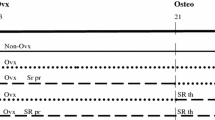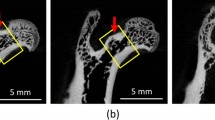Abstract
Introduction
Strontium ranelate (SrR) is suggested to function as a dual-acting agent in the treatment of postmenopausal osteoporosis with anti-resorptive and anabolic skeletal benefits. We evaluated the effects of SrR on the skeleton in ovariectomized (OVX) rats and evaluated the influence of dietary calcium.
Methods
Three-month old virgin female rats underwent ovariectomy (OVX, n = 50) or SHAM surgery (SHAM, n = 10). Four weeks post-surgery, rats were treated daily by oral gavage with distilled water (10 ml/kg/day) or SrR (25 or 150 mg/kg/day) for 90 days. Separate groups of animals for each dose of SrR were fed a low (0.1%) or normal (1.19%) calcium (Ca) diet. Static and dynamic histomorphometry, DXA, μ-CT, mechanical testing, and serum and skeletal concentrations of strontium were assessed.
Results
SrR at doses of 25 and 150 mg/kg/day did not increase bone formation on trabecular or periosteal bone surfaces, and failed to inhibit bone resorption of trabecular bone regardless of Ca intake. There were no improvements in bone mass, volume or strength with either dose of SrR given normal Ca.
Conclusion
These findings demonstrate that SrR at dosages of 25 and 150 mg/kg/day did not stimulate an anabolic bone response, and failed to improve the bone biomechanical properties of OVX rats.




Similar content being viewed by others
References
McCaslin F, Janes J (1959) The effect of strontium lactate in the treatment of osteoporosis. Proc Mayo Clin 34:329–334
Shorr E, Carter AC (1952) The usefulness of strontium as an adjuvant to calcium in the remineralization of the skeleton in man. Bull Hosp Joint Dis 13:59–66
Reginster JY, Seeman E, De Vernejoul MC, Adami S, Compston J, Phenekos C, Devogelaer JP, Curiel MD, Sawicki A, Goemaere S, Sorensen OH, Felsenberg D, Meunier PJ (2005) Strontium ranelate reduces the risk of nonvertebral fractures in postmenopausal women with osteoporosis: Treatment of Peripheral Osteoporosis (TROPOS) study. J Clin Endocrinol Metab 90:2816–2822
Meunier PJ, Slosman DO, Delmas PD, Sebert JL, Brandi ML, Albanese C, Lorenc R, Pors-Nielsen S, De Vernejoul MC, Roces A, Reginster JY (2002) Strontium ranelate: dose-dependent effects in established postmenopausal vertebral osteoporosis–a 2-year randomized placebo controlled trial. J Clin Endocrinol Metab 87:2060–2066
Meunier PJ, Roux C, Seeman E, Ortolani S, Badurski JE, Spector TD, Cannata J, Balogh A, Lemmel EM, Pors-Nielsen S, Rizzoli R, Genant HK, Reginster JY (2004) The effects of strontium ranelate on the risk of vertebral fracture in women with postmenopausal osteoporosis. N Engl J Med 350:459–468
Roux C, Reginster JY, Fechtenbaum J, Kolta S, Sawicki A, Tulassay Z, Luisetto G, Padrino JM, Doyle D, Prince R, Fardellone P, Sorensen OH, Meunier PJ (2006) Vertebral fracture risk reduction with strontium ranelate in women with postmenopausal osteoporosis is independent of baseline risk factors. J Bone Miner Res 21:536–542
Seeman E, Vellas B, Benhamou C, Aquino JP, Semler J, Kaufman JM, Hoszowski K, Varela AR, Fiore C, Brixen K, Reginster JY, Boonen S (2006) Strontium ranelate reduces the risk of vertebral and nonvertebral fractures in women eighty years of age and older. J Bone Miner Res 21:1113–1120
Burlet N, Reginster JY (2006) Strontium ranelate: the first dual acting treatment for postmenopausal osteoporosis. Clin Orthop Relat Res 443:55–60
Reginster JY, Sarlet N, Lejeune E, Leonori L (2005) Strontium ranelate: a new treatment for postmenopausal osteoporosis with a dual mode of action. Curr Osteoporos Rep 3:30–34
Seeman E (2007) Strontium ranelate. Osteoporosis, 3rd ed, Academic Press, pp 1767–1781
Arlot M, Jiang Y, Genant H, Zhao J, Burt-Pichat B, Roux J, Delmas P, Meunier P (2007) Histomorphometric and micro-CT analysis of bone biospsies from postmenopausal osteoporotic women treated with strontium ranelate. J Bone Miner Res 23:215–222
Barbara A, Delannoy P, Denis BG, Marie PJ (2004) Normal matrix mineralization induced by strontium ranelate in MC3T3-E1 osteogenic cells. Metabolism 53:532–537
Canalis E, Hott M, Deloffre P, Tsouderos Y, Marie PJ (1996) The divalent strontium salt S12911 enhances bone cell replication and bone formation in vitro. Bone 18:517–523
Takahashi N, Sasaki T, Tsouderos Y, Suda T (2003) S 12911-2 inhibits osteoclastic bone resorption in vitro. J Bone Miner Res 18:1082–1087
Baron R, Tsouderos Y (2002) In vitro effects of S12911-2 on osteoclast function and bone marrow macrophage differentiation. Eur J Pharmacol 450:11–17
Bonnelye E, Chabadel A, Saltel F, Jurdic P (2007) Dual effect of strontium ranelate: Stimulation of osteoblast differentiation and inhibition of osteoclast formation and resorption in vitro. Bone 42:129–138
Verberckmoes SC, De Broe ME, D’Haese PC (2003) Dose-dependent effects of strontium on osteoblast function and mineralization. Kidney Int 64:534–543
Ammann P, Shen V, Robin B, Mauras Y, Bonjour JP, Rizzoli R (2004) Strontium ranelate improves bone resistance by increasing bone mass and improving architecture in intact female rats. J Bone Miner Res 19:2012–2020
Marie PJ, Garba MT, Hott M, Miravet L (1985) Effect of low doses of stable strontium on bone metabolism in rats. Miner Electrolyte Metab 11:5–13
Marie PJ, Hott M, Modrowski D, De Pollak C, Guillemain J, Deloffre P, Tsouderos Y (1993) An uncoupling agent containing strontium prevents bone loss by depressing bone resorption and maintaining bone formation in estrogen-deficient rats. J Bone Miner Res 8:607–615
Buehler J, Chappuis P, Saffar JL, Tsouderos Y, Vignery A (2001) Strontium ranelate inhibits bone resorption while maintaining bone formation in alveolar bone in monkeys (Macaca fascicularis). Bone 29:176–179
Morohashi T, Sano T, Yamada S (1994) Effects of strontium on calcium metabolism in rats. I. A distinction between the pharmacological and toxic doses. Jpn J Pharmacol 64:155–162
Wronski TJ, Dann LM, Scott KS, Crooke LR (1989) Endocrine and pharmacological suppressors of bone turnover protect against osteopenia in ovariectomized rats. Endocrinology 125:810–816
Morohashi T, Sano T, Harai K, Yamada S (1995) Effects of strontium on calcium metabolism in rats. II. Strontium prevents the increased rate of bone turnover in ovariectomized rats. Jpn J Pharmacol 68:153–159
Ma YL, Bryant HU, Zeng Q, Schmidt A, Jee WS, Sato M (2005) Raloxifene and teriparatide (hPTH 1-34) have complementary effects on the osteopenic skeleton of ovariectomized rats. J Bone Miner Metab 23(Suppl):62–68
Fox J, Miller MA, Newman MK, Metcalfe AF, Turner CH, Recker RR, Smith SY (2006) Daily treatment of aged ovariectomized rats with human parathyroid hormone (1-84) for 12 months reverses bone loss and enhances trabecular and cortical bone strength. Calcif Tissue Int 79:262–272
Boivin G, Meunier PJ (2003) The mineralization of bone tissue: a forgotten dimension in osteoporosis research. Osteoporos Int 14(Suppl 3):S19–S24
Shahnazari M, Lang DH, Fosmire GJ, Sharkey NA, Mitchell AD, Leach RM (2007) Strontium administration in young chickens improves bone volume and architecture but does not enhance bone structural and material strength. Calcif Tissue Int
Skoryna SC (1981) Effects of oral supplementation with stable strontium. Can Med Assoc J 125:703–712
Parfitt AM, Drezner MK, Glorieux FH, Kanis JA, Malluche H, Meunier PJ, Ott SM, Recker RR (1987) Bone histomorphometry: standardization of nomenclature, symbols, and units. Report of the ASBMR Histomorphometry Nomenclature Committee. J Bone Miner Res 2:595–610
Lanzirotti A, Miller L (2003) Imaging and microspectroscopy at the National Synchrotron Light Source. Synchr Rad News 15:17–26
Criss J (1977) NRLXRF, A FORTRAN program for X-ray fluorescence analysis. Naval Res Lab, Washington, DC
Heaney R (2002) Protein and calcium: antagonist or synergists. Am J Clin Nutr 75:609–610
Sutton S, Bertsch PM, Newville M, Rivers M, Lanzirotti A (2002) Microfluorescence and microtomography analyses of heterogeneous earth and environmental materials. In reviews in mineralogy & geochemistry: applications of synchrotron radiation in low-temperature & environmental science. Mineralogical Society of America, Washington, DC, pp 429–483
Pors Nielsen S (2004) The biological role of strontium. Bone 35:583–588
Boivin G, Deloffre P, Perrat B, Panczer G, Boudeulle M, Mauras Y, Allain P, Tsouderos Y, Meunier PJ (1996) Strontium distribution and interactions with bone mineral in monkey iliac bone after strontium salt (S 12911) administration. J Bone Miner Res 11:1302–1311
Dahl SG, Allain P, Marie PJ, Mauras Y, Boivin G, Ammann P, Tsouderos Y, Delmas PD, Christiansen C (2001) Incorporation and distribution of strontium in bone. Bone 28:446–453
Farlay D, Boivin G, Panczer G, Lalande A, Meunier PJ (2005) Long-term strontium ranelate administration in monkeys preserves characteristics of bone mineral crystals and degree of mineralization of bone. J Bone Miner Res 20:1569–1578
Ozgur S, Sumer H, Kocoglu G (1996) Rickets and soil strontium. Arch Dis Child 75:524–526
Nielsen SP, Slosman D, Sorensen OH, Basse-Cathalinat B, De Cassin P, Roux CR, Meunier PJ (1999) Influence of strontium on bone mineral density and bone mineral content measurements by dual X-ray absorptiometry. J Clin Densitom 2:371–379
Blake GM, Fogelman I (2007) Effect of bone strontium on BMD measurements. J Clin Densitom 10:34–38
Bonjour JP, Ammann P, Rizzoli R (1999) Importance of preclinical studies in the development of drugs for treatment of osteoporosis: a review related to the 1998 WHO guidelines. Osteoporos Int 9:379–393
WHO (1998) Guidelines for preclinical evaluation and clinical trials in osteoporosis. World Health Organization, Geneva
Acknowledgements
We thank Lauren Waugh and Logan Vaught for their help in preparing the bone tissue for histological analysis and Antonio Lanzirotti for X-ray fluorescence data analysis. The Alliance for Better Bone Health (Procter & Gamble Pharmaceuticals and Sanofi-Aventis) provided the strontium ranelate drug substance and financial support for the study. The study was also funded by an NIH Musculoskeletal Training Grant T32 AR-7581–09. The National Synchrotron Light Source is funded by the U.S. Department of Energy, Office of Science, Office of Basic Energy Sciences, under contract No. DE-AC02–98CH10886. Portions of this work were performed at Beamline X26A, NSLS, Brookhaven National Laboratory, which is supported by the DOE-Basic Energy Sciences, Geosciences Division (DE-FG02–92ER14244 to the University of Chicago-CARS) and DOE-Office of Biological and Environmental Research, Environmental Remediation Sciences Division (DE-FC09–96-SR18546 to the University of Georgia).
Disclaimers/Funding Source
The Alliance for Better Bone Health (Procter & Gamble Pharmaceuticals and Sanofi-Aventis), NIH Musculoskeletal Training Grant T32 AR-7581–09, National Synchrotron Light Source funded by the U.S. Department of Energy, Office of Science, Office of Basic Energy Sciences (No. DE-AC02–98CH10886), Geosciences Division (No. DE-FG02–92ER14244 to the University of Chicago-CARS) and Department of Energy, Office of Biological and Environmental Research, Environmental Remediation Sciences Division (No. DE-FC09–96-SR18546 to the University of Georgia).
Author information
Authors and Affiliations
Corresponding author
Rights and permissions
About this article
Cite this article
Fuchs, R.K., Allen, M.R., Condon, K.W. et al. Strontium ranelate does not stimulate bone formation in ovariectomized rats. Osteoporos Int 19, 1331–1341 (2008). https://doi.org/10.1007/s00198-008-0602-6
Received:
Accepted:
Published:
Issue Date:
DOI: https://doi.org/10.1007/s00198-008-0602-6




